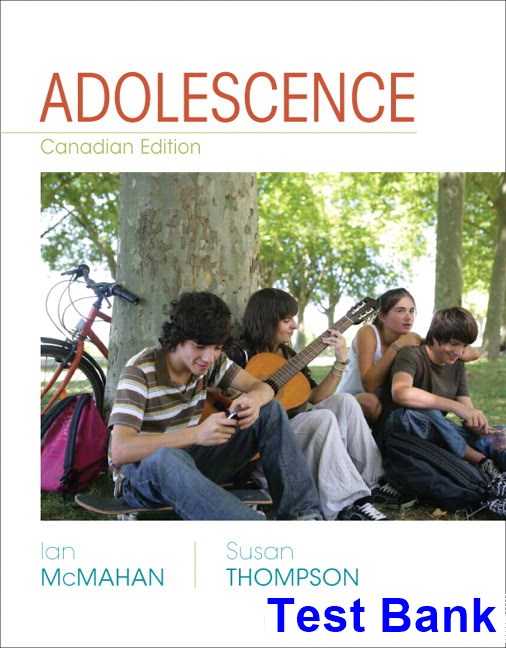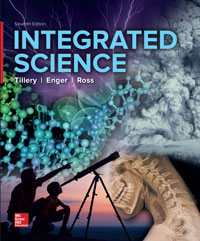Description
Test Bank For Adolescence Canadian 1st Edition By McMahan
Chapter 3: Cognitive Changes Multiple Choice Questions
1) The changes that take place in the ways adolescents think are known as
A) mental progress.
B) informational input.
C) cognitive development
D) knowledge processing.
Answer: C
Page Ref: 76
2) The most important figure to study how children’s thinking changes during development was
A) Sigmund Freud.
B) Jean Piaget.
C) Konrad Lorenz.
D) G, Stanley Hall.
Answer: B
Page Ref: 76
3) For Piaget, the process of trying to understand new information in terms of one’s existing knowledge is known as
A) interaction.
B) maturation.
C) accommodation.
D) assimilation.
Answer: D
Page Ref: 77
4) For Piaget, the process of changing one’s current ways of thinking in response to new experiences is known as
A) assimilation.
B) accommodation.
C) interaction.
D) maturation.
Answer: A
Page Ref: 77
5) According to Piaget, young adolescents enter the stage of _____, in which thinking is based on an abstract system of logic.
A) concrete operations
B) abstract operations
C) formal operations
D) logical operations
Answer: C
Page Ref: 78
6) When trying to understand social relationships in her new school, Farah generates a set of hypotheses about who is friends with whom, then systematically looks for evidence to confirm or disconfirm them. Piaget would place Farah in the _____ stage of cognitive development.
A) sensorimotor
B) preoperational
C) concrete operational
D) formal operational
Answer: D
Page Ref: 78
7) The competence-performance gap is likely to be larger when
A) the adolescent’s attention is divided among different problems.
B) the material fits well with the teen’s own views.
C) the matter is personally relevant.
D) the information being considered is more familiar.
Answer: A
Page Ref: 79
8) Patrick, a 10th grader, does not believe there are such things as UFOs. He is most likely to notice illogical reasoning when reading an article that
A) discusses the benefits and costs of globalization.
B) argues for the existence of UFOs.
C) argues that UFOs are imaginary.
D) explains why 10th graders are superior to younger adolescents.
Answer: B
Page Ref: 79
9) “Cars have four wheels. This object has four wheels, so it’s a car.” This is an example of
A) hypothetico-deductive reasoning.
B) metalogical analysis.
C) inductive reasoning.
D) preoperational thinking.
Answer: C
Page Ref: 79
10) Adolescents are more likely than children to measure their world against abstract concepts such as fairness and justice and to propose ways to improve it, reflecting their greater ability to
A) understand metaphor.
B) use inductive reasoning.
C) think hypothetically.
D) infer conclusions.
Answer: C
Page Ref: 80
11) Adolescents can better grasp sayings such as “When it rains, it pours” through their ability to
A) mentally compare explicit and implicit meanings.
B) understand grammatical rules.
C) ignore abstract relationships.
D) stay focused on concrete aspects of objects.
Answer: A
Page Ref: 81
12) The ability to attend to multiple meanings helps adolescents appreciate
A) concrete information.
B) sarcasm.
C) egocentrism.
D) inductive reasoning.
Answer: B
Page Ref: 81
13) Compared to younger children, adolescents are better at
A) thinking about possibilities.
B) understanding the world in abstract terms.
C) seeing what is as a particular case of what might be.
D) All of the above.
Answer: D
Page Ref: 81
14) The “imaginary audience” is one way that adolescent _____ shows itself.
A) abstraction
B) accommodation
C) egocentrism
D) operationalism
Answer: C
Page Ref: 82
15) As Luigi walks by two girls, one glances at him, then returns to her conversation. He is sure she is making a negative comment about him. Elkind would see this as an example of
A) introspection.
B) the imaginary audience.
C) impression formation.
D) a personal fable.
Answer: B
Page Ref: 82
16) “This is the worst thing that ever happened to anyone!” Statements of this sort reflect the influence of
A) Internet chatrooms.
B) dramatic license.
C) the personal fable.
D) concrete operations.
Answer: C
Page Ref: 83
17) Tiffany is aware that unprotected sex can lead to pregnancy and sexually transmitted infections, but she tells her friends that if she became sexually active, she knows nothing bad would happen to her. Elkind would see this as an example of
A) counterfactual thinking.
B) a personal fable.
C) metacognition.
D) the imaginary audience.
Answer: B
Page Ref: 83
18) Research on the imaginary audience suggests that
A) teens show off even if no one is looking.
B) young adolescents are more egocentric than older adolescents.
C) risky behaviour is more likely in the company of peers.
D) often others really are watching and judging.
Answer: D
Page Ref: 83
19) Campaigns to prevent risky behaviours by teens may be less effective because _____ leads teens to believe that bad things are likely to happen to others but not to themselves.
A) formal operational thinking
B) the personal fable
C) probabilistic reasoning
D) the imaginary audience
Answer: B
Page Ref: 83
20) Piaget’s theory has been criticized on the ground that
A) many older adolescents fail to show formal operational thinking.
B) the distinctions among stages are not strict enough.
C) it does not focus enough on mental structures.
D) All of the above.
Answer: A
Page Ref: 85
21) Kurt Fischer’s approach to cognitive development differs from Piaget’s in
A) focusing on coordinated skills rather than stages.
B) giving a less important role to the social environment.
C) maintaining that different areas of cognitive functioning develop evenly.
D) rejecting the idea of sensorimotor intelligence.
Answer: A
Page Ref: 86
22) The area between those things you can do on your own and those you could do if guided by someone more skilled than you is what Vygotsky termed
A) the social environment.
B) the competence-performance gap.
C) the zone of proximal development.
D) the region of dynamic skills.
Answer: C
Page Ref: 87
23) According to Robbie Case, adolescents are better than children at solving problems because of their use of _____ to mentally represent the goal and possible strategies to reach it.
A) scaffolding
B) concrete operations
C) metaphors
D) executive control structures
Answer: D
Page Ref: 88
24) A discussion of adolescent thinking that features such terms as input, working memory, and executive function most likely reflects the _____ approach to the subject.
A) cognitive developmental
B) information processing
C) psychometric
D) neuropsychological
Answer: B
Page Ref: 88-89
25) According to the information processing approach to cognition, if some piece of information engages your attention, it is passed along to
A) motoric control.
B) working memory.
C) the executive function.
D) comparison units.
Answer: B
Page Ref: 89





Be the first to review “Test Bank For Adolescence Canadian 1st Edition By McMahan”